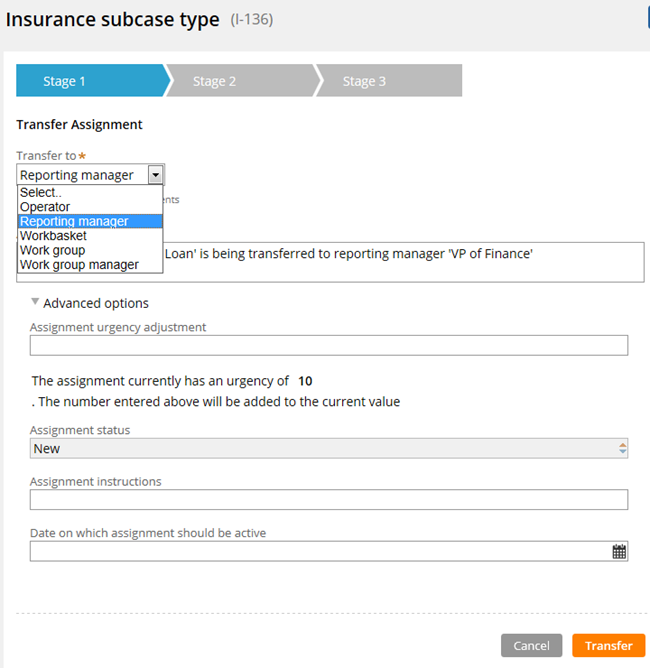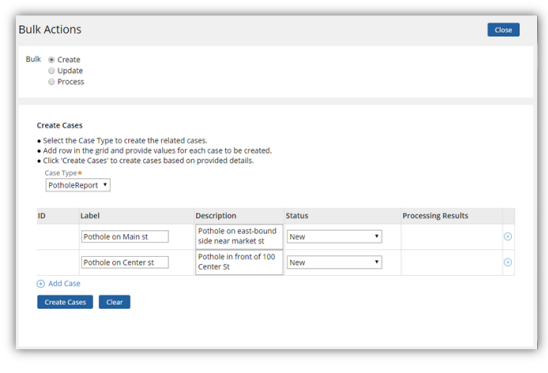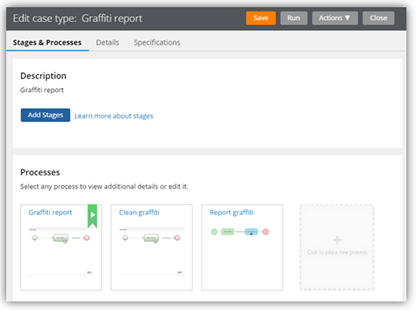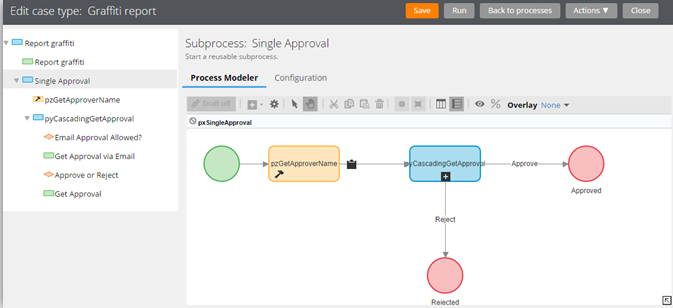Post files and links with pxPostMessage API
Valid from Pega Version 7.1.4
The pxPostMessageAPI now supports text messages, file attachments, and hyperlinks. You can programmatically update Pulse streams using this API from activities or SLA rules.
Case Management
Valid from Pega Version 7.1.4
This release has continued to focus on improving the functionality of the design environment with improvements to the Case Designer and stage configuration. Additional end user capabilities were also added to allow for processing a wider variety of cases, for those with and without stages and improved bulk processing handling.
- Flow action processing now uses the primary page instead of the interest page when using case/stage local actions, so that embedded flows are properly populated.
- Case-wide local actions rely on pzInternalStageFlow when there are no active, non-hidden assignments on the case. These case-wide local actions will now appear on a stage-less flow with no assignments.
- If a (valid) error is displayed in the outline view, saving or clicking around will not delete the error - the error will remain as a reminder to the developer to solve whatever problem is being flagged.
- May now add Cascading Approval validation and edit the parameters from the Case Designer Stage and Step page.
- Page labelling ("Page 1 of X") appears in the history list presented in the audit tab.
- The bulk processing feature has been enhanced.
- The Outline View functionality was changed so that the visible page will no longer refresh each time a flow is edited.
- The Post value was added to the instructions text field, so data isn't lost between nodes in the outline View.
- When Assign to Operator or workbasket is included as a filter, the bulk processing gadget is supposed to get a list of assignments. The UI for the results was enhanced for assignments to include a column for instructions so that the different assignments on the same work item can be distinguished.
- When designing a case type’s stages, it is no longer possible to skip the last stage (by using the "skip stage when" setting). When creating or editing the last stage, developers may no longer set a skip when rule; if tried, the system will display a warning and prevent that. If a Skip When rule is set up for a stage, and then all the intervening stages are deleted so that this stage becomes the last stage, the warning will display, and the Skip When rule will not be visible. If another stage is then added after that, the Skip When rule becomes visible again.
- When one or more locked work objects are processed using the Process Selected Items button, the action will be performed on the selected work objects. If the action is successful, a green tick appears on the work object. If it is not successful, a red cross will appear.
- When the topmost RuleSet in the RuleSet Stack is locked, customers may now open up Outline View by clicking "Configure Process Details" and make exploratory changes to experiment. Because the RuleSet is locked, these changes may not be saved, but the experiment can be tried.
Quickly create ad-hoc cases
Valid from Pega Version 7.1.4
The My Cases work area on the Case Manager portal introduces a Quick Create feature that lets users create cases and assign tasks that are not included in the processing of business cases (instances of case types defined in the Cases Explorer). For example, a manager can create a case and a task to set up a phone conference with her staff, or a reminder to enroll in an online seminar. Users can also set up a series of tasks to represent all they work they need to do to accomplish a specific goal.
Certain flow actions deprecated and replaced
Valid from Pega Version 7.1.7
To ensure compatibility with supported browsers and mobile devices and to enhance ease of design, the following flow actions are deprecated and replaced. As a best practice, use the replacement actions for new development. The deprecated rules are still supported and do not have to be updated.
| Deprecated | Replacement |
|---|---|
| Transfer | Transfer Assignment |
| TransferAdvanced | " |
| TransferToManager | " |
| TransferToWorkbasket | " |
| Approve | Approval |
| Reject | " |
| AttachAFile | Attach Content |
| pyAdjustSLA | Adjust Assignment SLA |
| pyAdjustSLATimes | " |
| pyChangeAssignmentSLA | " |
| pyUpdate | Update Case |
For example, the new Transfer Assignment action supports the most common routing options such as operator, workbasket, and reporting manager. Advanced options allow users to escalate, set due dates, update status, and provide instructions.

Transform Assignment form
See Atlas - Standard Flow Actions (Local).
Service levels are available on stage steps
Valid from Pega Version 7.1.7
For greater flexibility when configuring stages, you can associate a service level (SLA) with a step within the context of the stage only. Because this SLA overrides the one associated (if defined) with a a step, other steps that employ the same flow are not affected and can be configured independently.
See Using the Stages & Processes tab.
Managers can create and update cases using the Bulk Actions tool
Valid from Pega Version 7.1.7
The capabilities of the Bulk Actions tool have been expanded so that managers can go beyond simply being able to make bulk updates to existing cases. They can now:
- Create top-level cases for any case type in your application. By default, you can specify the label, description, and work status for each case.
- Define the case information you want to display on the grid by overriding the section pyBulkUpdate and configuring the columns.
- Update the case information you created in the Bulk Actions tool.

Create Cases option in the Bulk Actions tool
See Case Manager Portal — How to process assignments and cases in bulk.
Define distinct names to implementation and framework class layers in Application Express
Valid from Pega Version 7.1.7
When generating both implementation and framework applications in Application Express, you can now name the framework application and workpool class layers independently. This eliminates the need to update a framework's class structure in the new application. Previously, the framework layers used the same names as the implementation and could not be updated.

Class structure name fields in Advanced Configuration dialog
See Application Express — Advanced Configuration.
New case types contain one stage
Valid from Pega Version 7.1.7
When you create a new case type in the Cases Explorer or in Application Express, the system creates only one default stage. A single starting stage provides an intuitive design experience and eliminates the need to delete unused stages. Previously, a new case type contained three default stages.
Edit process-based case type flows in Case Designer Process Outline view
Valid from Pega Version 7.1.7
If your case type does not employ a stage-based design, you can now employ the Step Tree and other features available in Process Outline view to facilitate your design.
Click a process tile in the Stages & Processes tab to open the flow in Process Outline. In this example, the Graffitti report is selected.

Processes in Stages & Processes tab
The process opens in Process Outline view. Note that the tree view allows you to easily see and update the underlying shapes and subprocess that compose the Single Approval process.

Process in Process Outline view
Both Transfer and Transfer Assignment flow actions are displayed in the Bulk Actions tool
Valid from Pega Version 7.1.7
Both the deprecated Transfer flow action and its Pega 7.1.7 replacement Transfer Assignment (pyTransferAssignment) might appear in the menu on the Bulk Actions tool.
Either of the following situations can cause this behavior:
- The original application did not contain the UI-Kit-7 ruleset, for example, the application was built on Pega 7.1.5.
- The default flow actions are based on BulkProcessTransferFlowAction system settings.
- If you add pyTransferAssignment as a local action in a case type rule, users will see both old and new actions.
- The flow actions are still available unless you override the settings.
- The upgraded application uses the UI Kit ruleset, but the Transfer local action was defined in the original case type rule and copied to the application.
- The original is explicitly defined in the application.
- pyTransferAssignment is available through the system settings in the UI Kit.
As a best practice, upgrade Transfer flow actions to Transfer Assignment in your flows and local actions. The UI Kit ruleset ensures that the new flow actions are optimized for mobile interfaces. In addition, Transfer Assignment provides multiple transfer functions (to manager, workbasket, advanced options) in a single form.
Alternatively, keep the original system settings so that the existing flow actions are still available.

